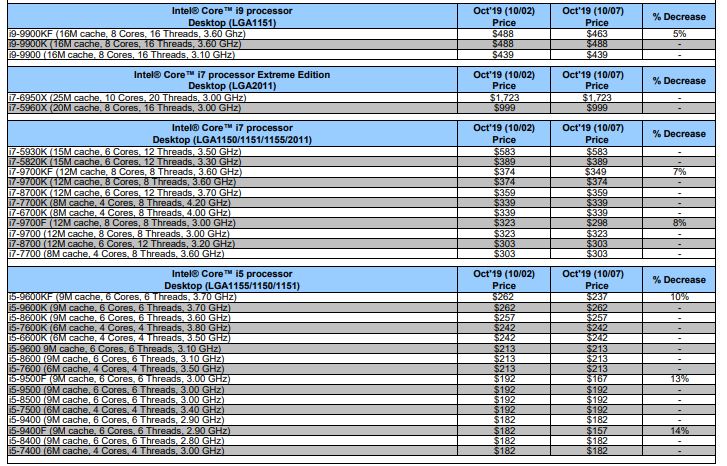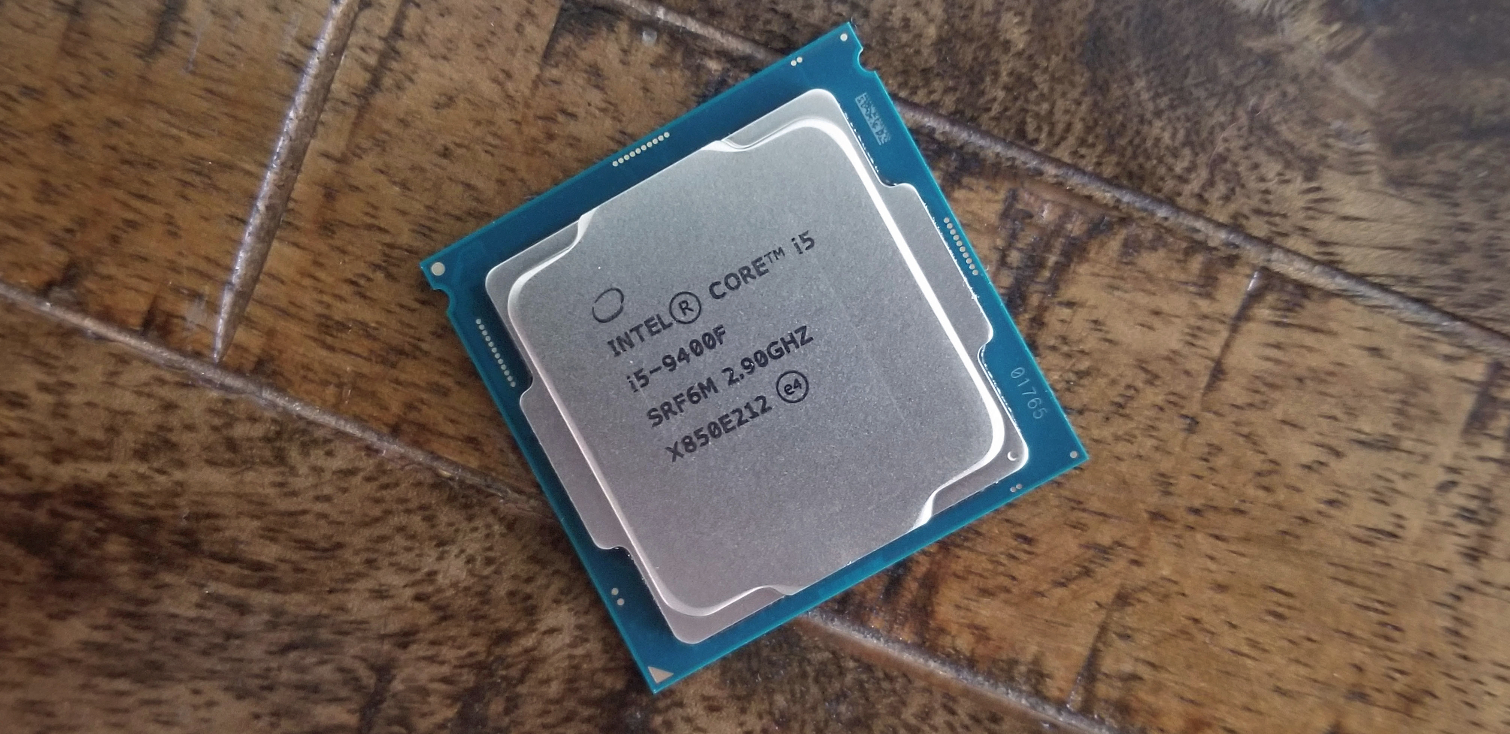Intel Cuts 9th-Generation F- and KF-Series Pricing by up to 20 Percent
In yet another sign of the mounting pressure from AMD's Ryzen 3000-series chips, the company announced today that it would drop the pricing of its graphics-less F-series chips up to 20%, marking the first time the company has reduced pricing on existing chips in recent memory.
Intel's F-Series chips come with disabled internal graphics due to manufacturing defects that would normally render the chips unusable. The F-Series chips arrived with no formal announcement from the company in December 2018 as the company was mired in the throes of its continuing shortage of 14nm production capacity. At the time of release, the chips came with absolutely no discount over their full-featured counterparts.
| Row 0 - Cell 0 | Cores / Threads | Base / Boost (GHz) | Unlocked | Old Price | New Price | % Change |
| Core i9-9900KF | 8 / 16 | 3.6 / 5.0 | Yes | $488 | $463 | 5% |
| Core i7-9700KF | 8 / 8 | 3.6 / 4.9 | Yes | $374 | $349 | 7% |
| Core i5-9600KF | 6 / 6 | 3.7 / 4.6 | Yes | $262 | $237 | 10% |
| Core i3-9350KF | 4 / 4 | 4.0 / 4.6 | Yes | $173 | $148 | 14% |
| Core i7-9700F | 8 / 8 | 3.0 / 4.7 | No | $323 | $298 | 8% |
| Core i5-9500F | 8 / 8 | 3.0 / 4.4 | No | $192 | $167 | 13% |
| Core i5-9400F | 6 / 6 | 2.9 / 4.1 | No | $182 | $157 | 14% |
| Core i3-9100F | 4 / 4 | 3.6 / 4.2 | No | $122 | $97 | 20% |
Selling these chips allowed for the company to boost production, though the company never formally announced that the chips would remain a part of its strategy. As part of today's announcement, the company also said it would add F-Series chips to its long-term roadmaps, meaning enthusiasts will have budget options in the next generations of Intel's processors.
Integrated graphics do come in handy for QuickSync, troubleshooting, or if your graphics card fails, but under most conditions, the disabled graphics unit doesn't have an impact. As we've seen in our own testing, these chips offer the same levels of performance as their fully-equipped counterparts, simply because they feature the same architecture and 14nm process.


The price cuts impact both the unlocked "KF" and locked "F" models. For reference, this is the first time we've seen the far right column used in Intel's pricing guide.
Although the F-series chips officially sported the same recommended prices as Intel's fully-functional models, they've been a little cheaper in practice. Those savings have normally fallen in the $20 range. It's hard to tell if Intel's reduction in official pricing will result in further savings at retail, but it's logical to expect retail pricing to drop further.
Intel's response to AMD's Ryzen onslaught has typically been sluggish, largely because the company hasn't resorted to cutting prices on existing models. Instead, the company has slowly added more cores to its processor families with the release of new models, with those increased core counts equating to lower per-core pricing. The company has also added more features to some of its chips, like exposing more PCIe lanes for the downstream models. These price cuts seem to mirror a DigiTimes report earlier this year, though the cuts didn't include all of the 9th-gen models. In either case, it's encouraging to see Intel try a more direct pricing tactic to improve its value proposition.
Get Tom's Hardware's best news and in-depth reviews, straight to your inbox.
The price cuts are effective today for Intel's 9th-generation F-Series processors that are already in the market.

Paul Alcorn is the Editor-in-Chief for Tom's Hardware US. He also writes news and reviews on CPUs, storage, and enterprise hardware.
-
namesurename 9500f has 6 cores, not 8, otherwise it would be decent cpu for the price.Reply
9100f is 4 core too... -
slash3 Less interesting, yet still accurate headline: "Intel cuts 9th generation CPU prices by $25"Reply -
mdd1963 I was rather hoping to see that 20% price trim on the 9900K and 9700K, vice the $25 cuts actually given to the two actual models worth buying... :)Reply
(Certainly, they had to do this though, as the lesser models were such clear jokes as to be almost funny; price cuts do work) -
TerryLaze These are the prices that the F chips have been selling for the last year or so,at least for the 9400f that I was semi interested in,it is as low as $150 since jun.Reply
https://pcpartpicker.com/product/T47v6h/intel-core-i5-9400f-29-ghz-6-core-processor-bx80684i59400f -
joeblowsmynose ReplyTerryLaze said:These are the prices that the F chips have been selling for the last year or so,at least for the 9400f that I was semi interested in,it is as low as $150 since jun.
https://pcpartpicker.com/product/T47v6h/intel-core-i5-9400f-29-ghz-6-core-processor-bx80684i59400f
The prices listed in the article are based around 1000 units - these aren't "street" prices.
Street prices are never the same as the prices Intel lists as recommended price - so expect the street prices to go down some in response to this price cut. -
joeblowsmynose Replymdd1963 said:I was rather hoping to see that 20% price trim on the 9900K and 9700K, vice the $25 cuts actually given to the two actual models worth buying... :)
(Certainly, they had to do this though, as the lesser models were such clear jokes as to be almost funny; price cuts do work)
Yeah I wonder if the regular line will eventually get cuts too ...
-The new Xeon "W" series - up to 50% price reduction over previous line (with a slight performance bump too)
-The new HEDT parts we know have up to 54% price reduction
-20% price cut on "F" lineup parts ...
-I am sure that with 64 core Rome going for under $8000, regular Xeon isn't being sold for anywhere near their listed prices (or at least won't be for 2020)
That pretty much just leaves their main desktop line left ... (9700k and 9900k more specifically)
I think they are waiting to see how both AMD's new upcoming microcode update (performance improvements are supposedly coming) affects performance in games and light threaded tasks, and waiting on the final 3950x performance numbers in gaming, before deciding to make any changes to the 9900k and 9700k pricing.
If they can still eek out a tiny win in a non-typical, bottlenecked gaming scenario, they'll be all like "See! If you want to game you NEED Intel!" - and people who don't understand when a CPU is and is not bottlenecked in a game will be like "Wow! Really!? Take my extra money then Intel, please!"
And Intel will sit back with a big smile and say ... "See investors? We still got what got you to this point. We don't even need new chips"
Something along those lines :)
But more seriously, I am sure even a small cut to 9900k and 9700k would be most welcome amongst their customers.
